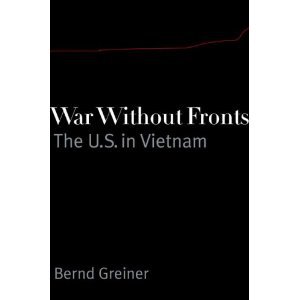1.
In War without Fronts: The USA in Vietnam, German historian Bernd Greiner explains his focus:
“At the heart of this book are the wartime atrocities and war crimes committed by the ground troops. To be more precise, acts of violence which were carried out in close proximity to the victims and in the full knowledge of their identity. We are talking of attacks on the physical inviolability of non-combatants or those no longer involved in fighting—-torture, rape, murder and mutilation. The victims are not tormented, abused, or murdered from an anonymous distance, are not harmed by aerial weapons and bombs but move in sight of the perpetrators and frequently come face to face with them. The international laws governing warfare—from the Hague Convention on the conduct of land warfare to the various Geneva Conventions—address primarily, though not exclusively, this type of violence. It can neither be brushed off as ‘collateral damage’ nor excused as the unintentional price of operations, nor is it aimed at the troops, logistics or material resources of the enemy. This is violence committed outside the theaters of war and beyond the hostilities, where the perpetrators do not fight like soldiers but slaughter like cowardly marauders. Because they do not accept any front lines, they regularly, if not systemically, extend the area of operations to the civilian population and shrink from as little from attacks on individuals as from group massacres.”
2.
Some passages …
General William Westmoreland: “We’ll just go on bleeding them until Hanoi wakes up to the fact that they have bled their country to the point of national disaster for generations. Then they will have to reassess their position.” [56]
Head of Operations for U.S. Forces William Dupuy: “The solution in Vietnam is more bombs, more shells, more napalm… till the other side cracks and gives up… We are going to stomp them to death.” [55]
A U.S. soldier in 1967: “They’re all VC or at least helping them—same difference. You can’t convert them, only kill them. Don’t lose any sleep over those dead children—they grow up to be commies too… This is a war and we have to stop the commies any way we can, using whatever we’ve got.” [84]
And the Army’s defense for U.S. troops throwing grenades at children: “The children had come from a village from which hostile fire had come, and it was possible that they may be terrorists.” [302]
An Air Force captain: “In the Delta, the villages were very small, like a mound in a swamp. There were no names for some of them…the U.S. Air Force had spotters looking for muzzle flashes, and if that flash came from that dot, they’d wipe out the village. It was that simple.” [69]
American advisor John Paul Vann: “I recall in May 1969 the destruction and burning by air strike of 900 houses in a hamlet in Chau Doc Province without evidence of a single enemy being killed.” [70]
U.S. journalist Seymour Hersh: “The classic killer in Vietnam is the helicopter man who just goes around and shoots anybody…And that isn’t hyperbole… You know, in terms of numbers, the massacres committed by helicopters certainly outweigh the massacres committed by men like Calley.” [81-82]
A juror who had to reach a verdict on U.S. soldiers/rapists: “We’re not going to ruin the lives of these young Marines for some Vietnamese.” [328]
A Special Forces soldier: “We really got a chance to act it out and there was no mommy to scold us, no principal’s office to be sent to.” [175]
U.S. journalist Kevin Buckley: “In my opinion, the U.S. military has been guilty of more than recklessness. It can, I believe, be documented that thousands of Vietnamese civilians have been killed deliberately by U.S. forces.” [270]
A soldier: “When we kill a pregnant woman, we count it as two V.C.—one soldier and one cadet.” [84]
General George Patton’s 1968 Christmas card featured a photo of a stack of dead and mutilated Vietnamese Communists with the words “Peace on Earth.” [109]
3.
The following comment is from Martha Hess’s collection of interviews, Then the Americans Came: Voices from Vietnam (Four Walls Eight Windows, 1993).
Mrs. Phung Thi Tiem: “Many people are handicapped today. Many people lost everything in the war, and can’t support themselves. So you can tell the American government to make reparations. To be fair, the Vietnamese didn’t send troops to invade America. Never, never forget. We remember the war. We remember our losses. All the little children—nine years old, thirteen, they had committed no crimes for the Americans to come and kill them. When they died in the bombings, their eyes popped out from the compression. Their bodies were mangled. Small children and old people. They lived here, and worked their whole lives here. They never sent troops to America. They never took one plant, one leaf from America. Why did the Americans come here to destroy everything, to kill the people, to kill small children, to kill even pregnant women—why? Don’t the American people even know why?” [64-65]
